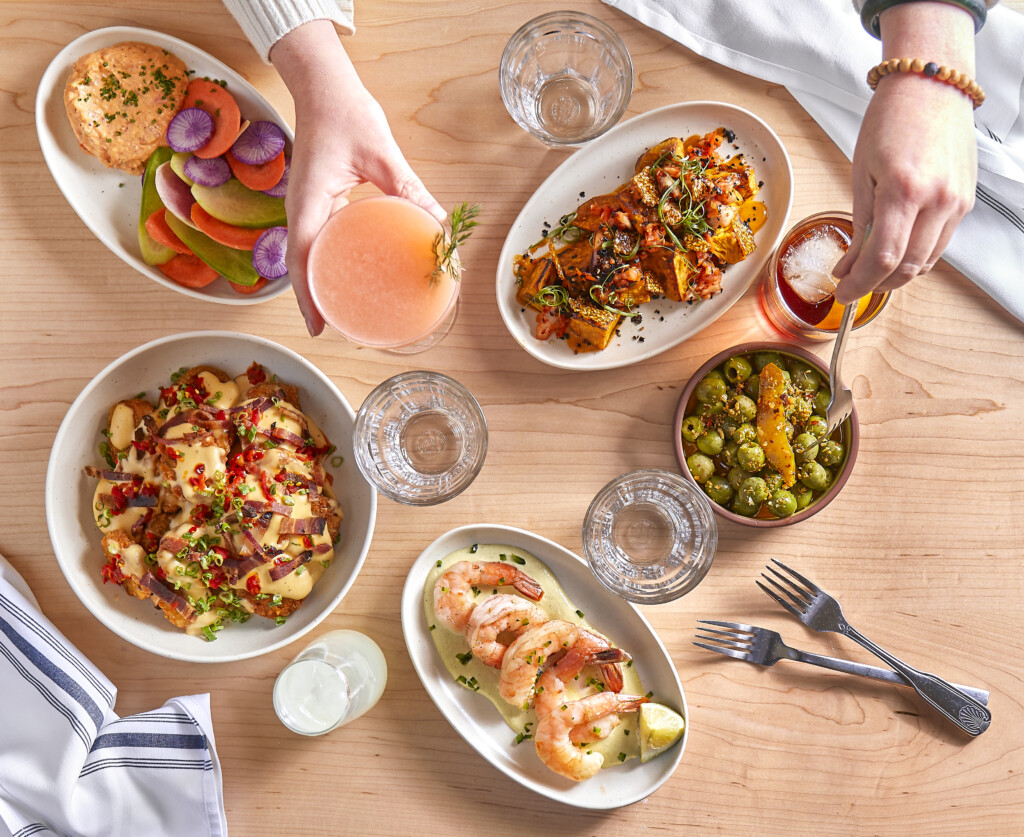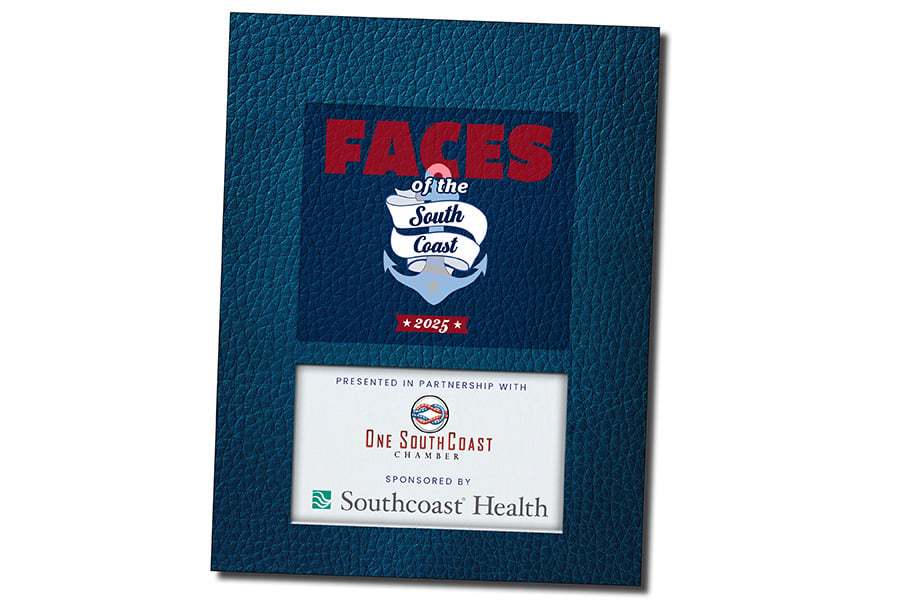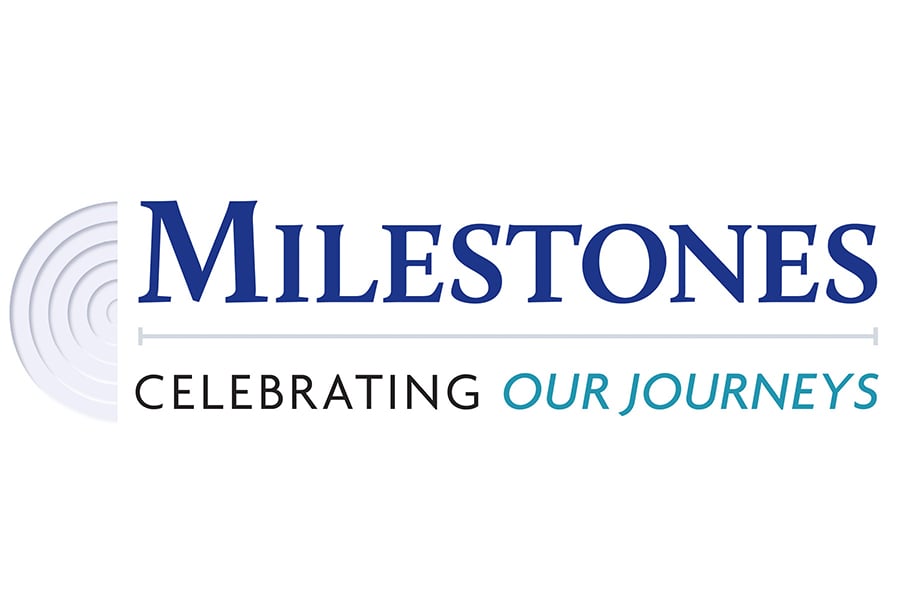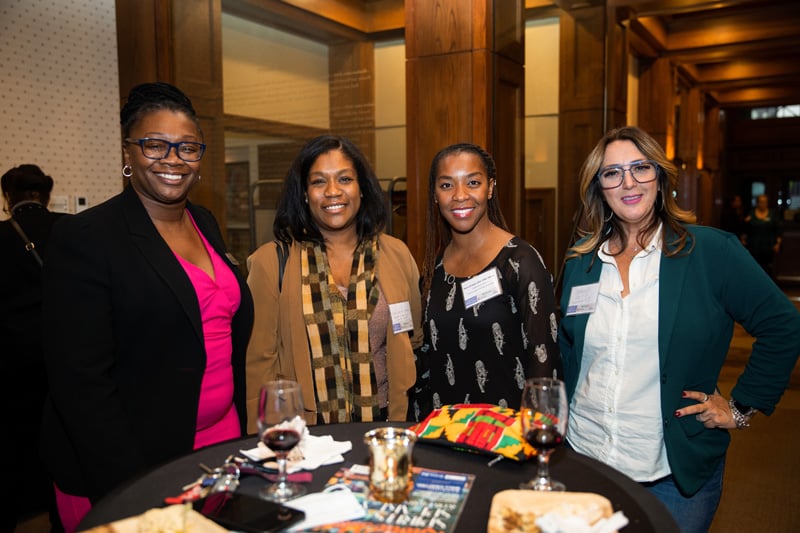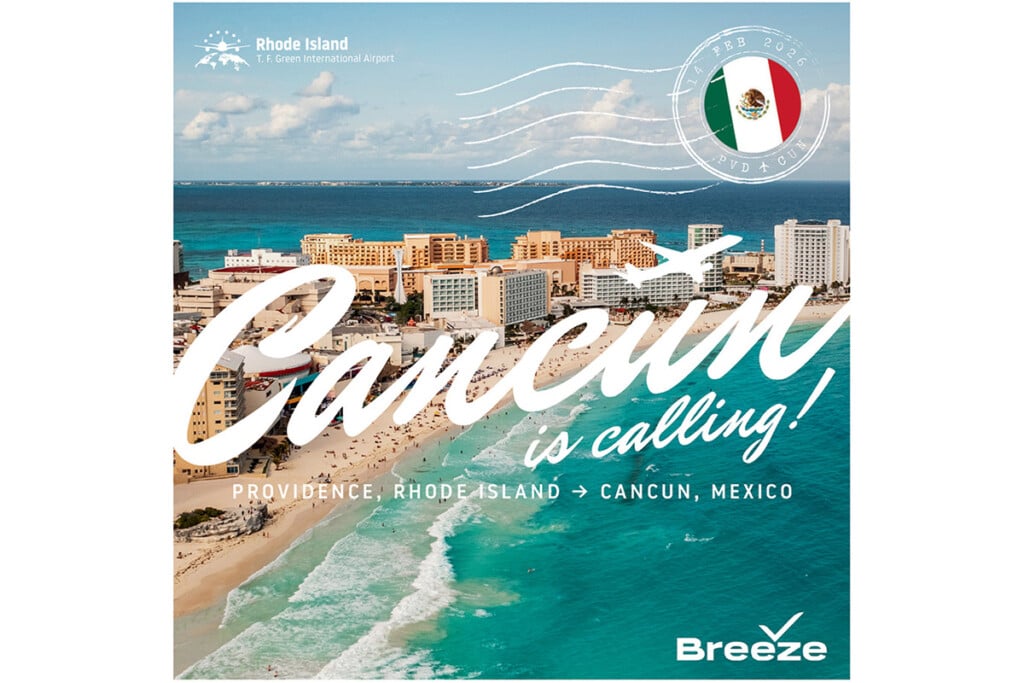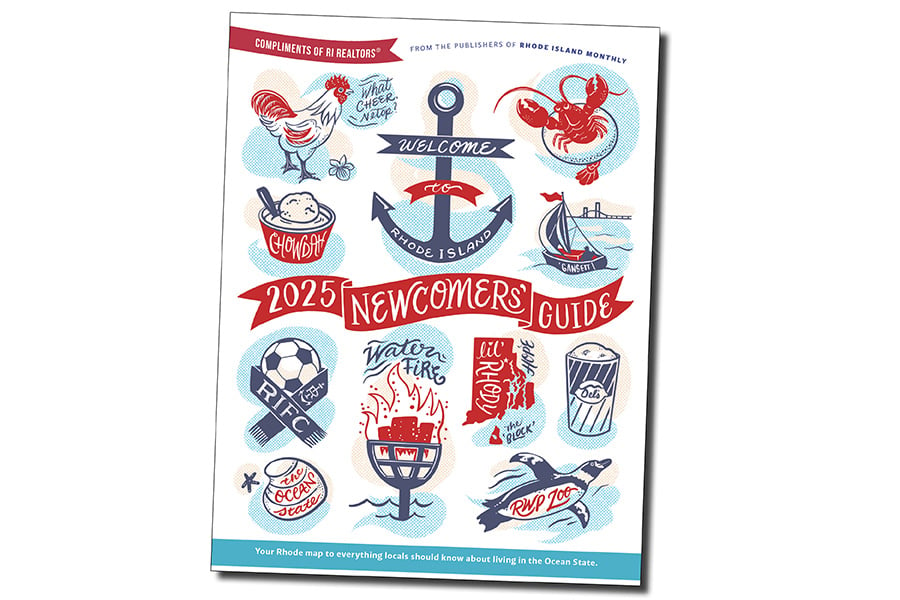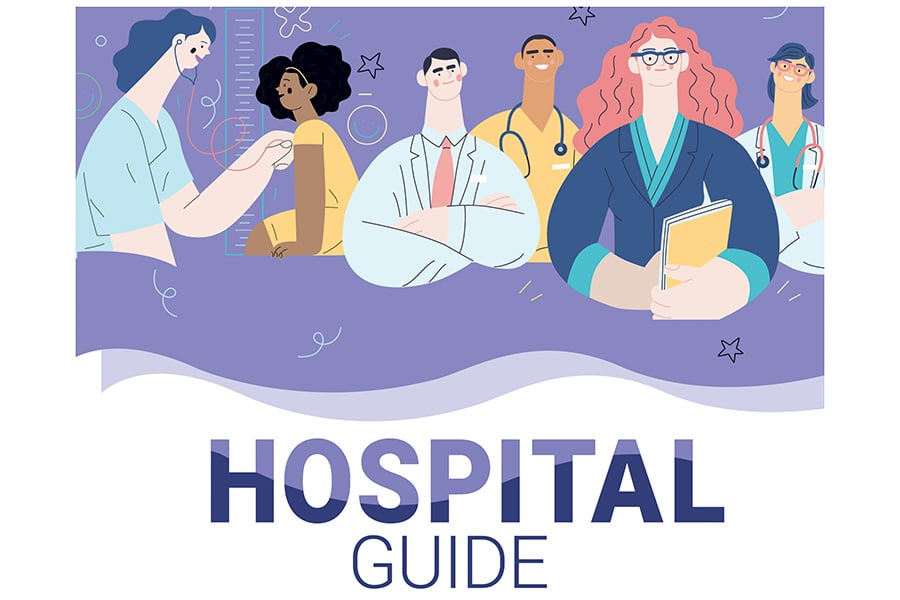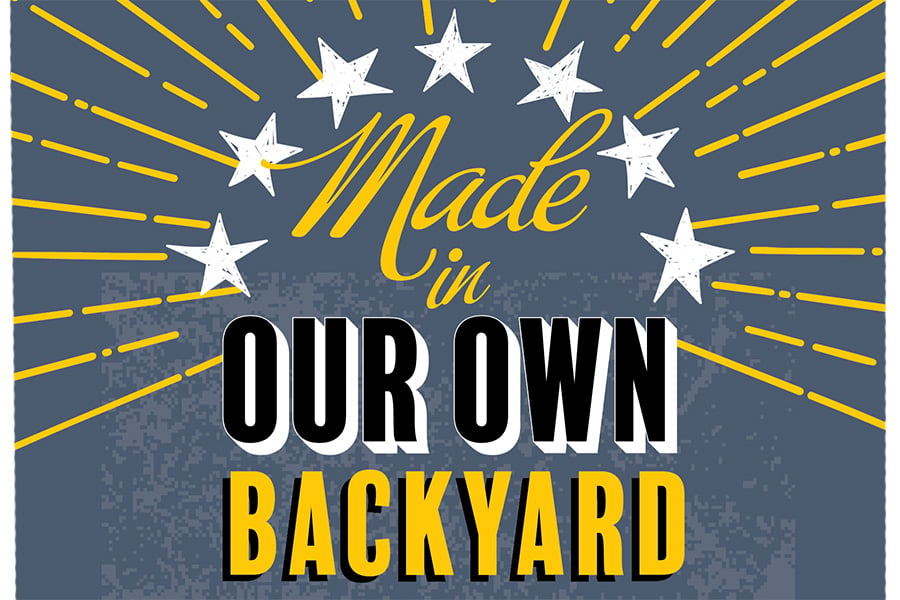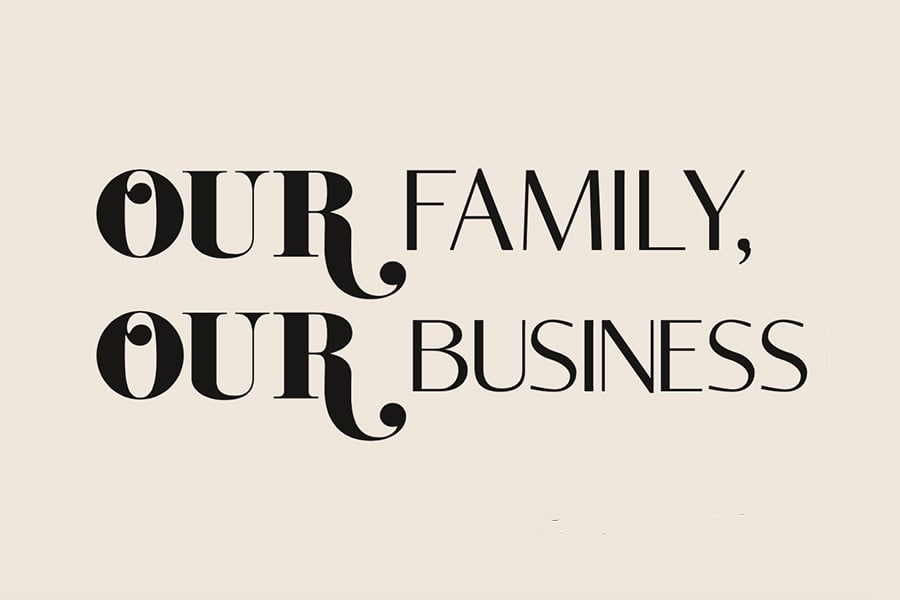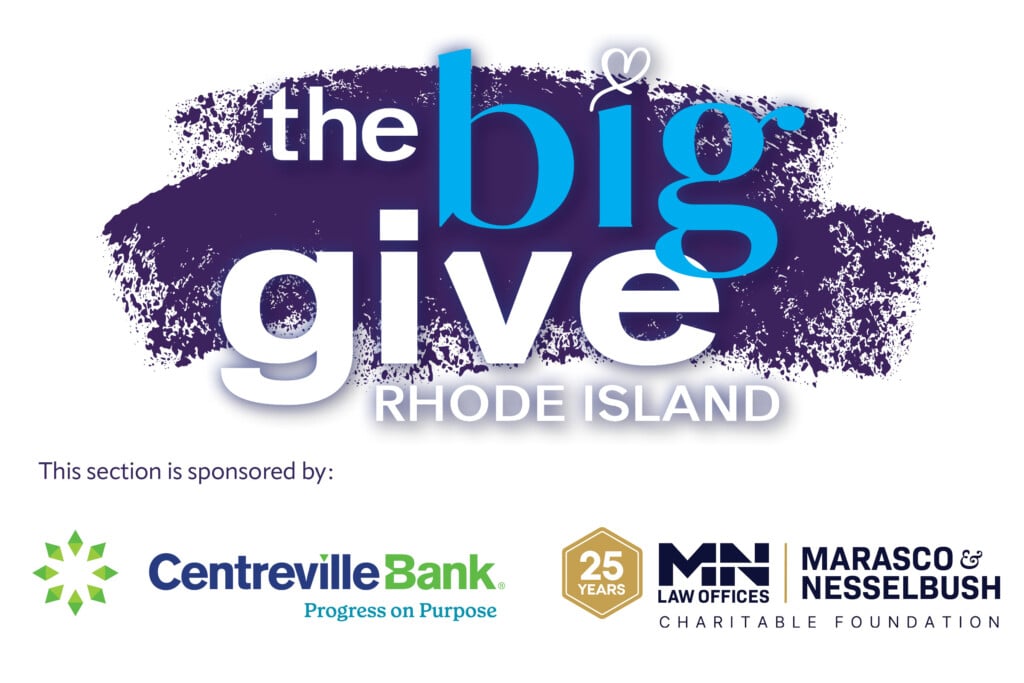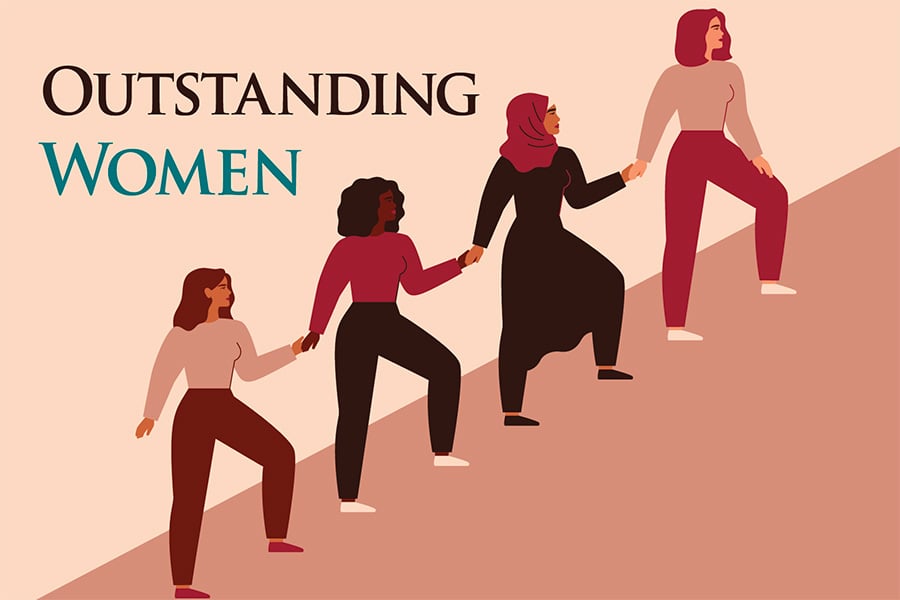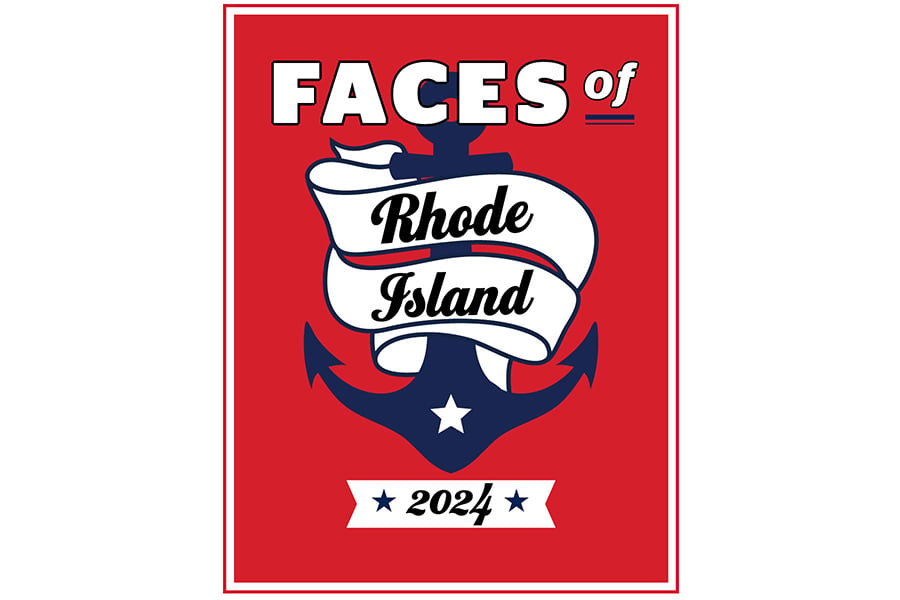Dive Into Rhode Island’s Unlikely Surfing Scene
The Ocean State has more of a surfing scene than you think, with a diverse group of wave chasers hitting the shore in all seasons and conditions.

Local surfer Claire Hodson poses in her cold weather gear with a longboard. Photography by Cate Brown

Hodson has been a regular in the South County surfing scene for more than thirteen years. Photography by Corey Favino
When people think of hanging ten, they most likely picture locations like California, Hawaii, South Africa and Tahiti. Famous films like The Endless Summer, Point Break and Blue Crush showcase the West Coast and West Indies as surfing meccas, but Rhode Island has a righteous surfing community of its own.
In fact, there’s a reason why Rhode Island earned the nickname the Ocean State. Rhode Islanders from all walks of life paddle out in every season, from stereotypical summer days to the dead of winter. Plus, there’s more diversity in the sport than ever, thanks to pioneers paving the waves for others. Between the break, you might find bookish high school teachers, diehard winter athletes, women, dads, people of color and kids with physical and developmental disabilities surfing among both kooks (beginners) and legends.
Here’s a look inside Rhode Island’s diverse surf scene.
The Transplant
Curtis Perdue was born and raised in Florida, where at a young age he and his brother picked up their love of surfing from their father.
“He was a surfer in the sixties,” Perdue explains. “He took us to see Endless Summer 2 the summer before I was in sixth grade, a sequel to the ’69 film about two guys who travel the world looking for the perfect wave. We didn’t know anything about surfing, but afterward we were enthralled.”
The boys insisted their father take them surfing. They got his board down from the attic, went to South Beach, and by the end of the day, the boys were catching their own waves.
As an adult, Perdue pursued a master’s in poetry at Emerson College, and fell in love with a woman from Massachusetts. They settled in Boston and had a child, but never truly felt at home in the city. It was a surfboard for sale on Craigslist that led Perdue to southern Rhode Island.
“I went down, bought the board, and was like, ‘This is a really cool place,’” Perdue says. “I told [my wife] all about it, and the following weekend we came back down to look at a few places in Wakefield and we put down an offer.”
The couple fell in love with the village’s quaint Main Street and its proximity to the ocean. “I don’t think people realize how special Rhode Island is for surfing,” he says. “I felt more at home here.”
Perdue has surfed all over the world with family and friends. But how does his Rhody backyard compare to heavyweights like Florida, Hawaii, Costa Rica, Panama, Puerto Rico or
El Salvador?
“Within fifteen minutes of my house, I’ve counted about fifteen different surf spots,” he says. “They all take different swell directions and wind directions and tides. To have that amount of variety is rare in such a small area. There’s something for all skill levels: beach breaks for beginners and point breaks and rock breaks for the more advanced surfers.”
He squeezes in a session before or after his day job as a high school English teacher.
“[My students] do know [I surf] and I think they want me to be the cool teacher, but I make sure to keep boundaries,” he says with a laugh. “There are a few kids, though, who are really into surfing and trying to get better, so I’ll talk to them and give pointers. It’s cool to build those relationships with them.”
As someone who recently placed third in a tournament down in Malibu, it’s clear Perdue knows his stuff in and out of the classroom.
“Beginning surfers tend to not be aware that there is this code, this unofficial rule book that has been cemented in surf culture,” he explains. “For example, people get a wave based on their positions in the water and how long they’ve been waiting. It’s dangerous if you just start paddling in on a wave that somebody else is on. I learned from my dad or by getting yelled at in Miami by older men. If you don’t have that, it’s hard to figure out on your own.”
The Lifelong Rider
“Surfing is a stereotypical type of sport. As soon as I tell somebody I surf, they’re like, ‘Whoa. Man. Bro. California!’ Normally you wouldn’t even know I’m a surfer,” says Warren resident Jimmy Fulton, a husband, father of three young kids, and an HVAC instructor at a technical high school in Taunton, Massachusetts. His other passion is beekeeping and harvesting honey at home.
Growing up with a quahogger for a father, Fulton always gravitated to the water. But his Warren address put him about fifteen miles north of the beach, and getting to the ocean on his own as a kid wasn’t easy (though he did try every way to get there, including RIPTA buses). He and his friends eventually took up skateboarding, and by the time he was fourteen, Fulton was ready to dive into his true passion of surfing.
Thirty-plus years later, Fulton is still at it, and he knows all the best spots, both locally and internationally. He recently took a surfing expedition to the Maldives, but it’s Rhode Island where he is a regular.
“There are plenty of ‘secret’ spots left — you find them by word of mouth or from research. You become this mini meteorologist: As a surfer you watch the winds, the tides, the storms, everything,” he says. “And it’s become easier now because we have technology, we have surf cameras and surf reports. I still actually call [local surf legend Sid] Abbruzzi’s surf line every single day.”
He believes the Ocean State is the surf capital of New England.
“In the summer, the waves are small and the water’s flat — it’s more beginner-friendly. That’s not our surf season,” he says. “If you go down to the beach after a winter storm, you would be amazed at how big the waves are. It gets cold, but wetsuit technology has evolved, and sometimes you’ve got to have grit.”
Speaking of, he’s earned his place at Ruggles. For those not in the know, this not-so-secret-yet-still-pretty-mysterious surfing spot in Newport is not for the faint of heart or the inexperienced.
“Ruggles is a point break; it’s rock, it’s more powerful, it’s a little dangerous. You must know what you’re doing before you go out to those kinds of breaks,” he warns. “And the Newport crowd, they’re a hardy bunch of surfers. You’ve got to be a little bit tough, thick-skinned. If someone is there that doesn’t have the ability, somebody’s going to let them know right away. Like, ‘Dude, you gotta go.’”
It’s not about being exclusive. It’s about safety. But in the end, everyone is out for a good time.
“I love being in the water. It’s like my medication. Some people go to therapy — I go for a paddle, I go for a surf,” Fulton says. “There’s nothing like being out in nature and it’s just you and the elements.”
The Athlete
Connecticut native Claire Hodson got stoked on the sport in her early college days. Her family summered in South County when she was a kid and she started out renting boards on Narragansett Town Beach. It was her younger brother who helped her fully integrate into the local surf community.
“Once I started meeting people, they started taking me around to different spots and opening that door made me fall in love with longboarding,” she says. “I became good friends with [Soundings Surf Co. owner] Kevin Tanner and he taught me more about boards and waves and surf theory. I feel grateful that he guided me.”
She started out on a longboard because it was an easier entry point to the sport.
“I was a college ski racer, so I never really had time to do other sports throughout the winter,” she says. “I came to Rhode Island in the summer when the waves are smaller, and that’s when you want a bigger board.” Thirteen years later, she still prefers a more relaxed ride but also enjoys the challenge of a short board.
Now a South County resident, Hodson paddles out once or twice a week and sometimes once or twice a day, depending on the conditions. Having a fisherman and aquaculturist for a partner also has its benefits: He’ll let her know when and where waves will roll in. Plus, it helps to know the area.
“It’s funny, I’ve only surfed in Newport a couple times even though it’s only twenty minutes away. It’s such a Rhode Island mentality. [Surf spots] are very separate,” she explains. “That area has conditions and size that we don’t have here [in South County], but I just don’t venture over there.”
Still, she keeps her favorite spots close to her chest.
“I get annoyed when the water’s crowded like everyone else, but I try to take a step back and acknowledge that we’re all privileged to be here and to be in this space. If you come in with Massachusetts plates, you should have access as well, as long as you’re kind and respectful,” she says.
She also has grown to feel secure with her place as a woman among the swells.
“There are a lot more women in the water now, which is awesome. It’s nice being able to chat with them out there and on land. I even met my best friend while surfing,” she says.
Yet the perception that women surfers are not as capable still lingers. Hodson says even when she has priority on a bigger wave, some male surfers will paddle around or drop in on her.
“They’ll just say, ‘Oh, sorry, I didn’t think you were going to get that,’” Hodson says. “But there are also a lot of great men out there, too. Don’t get me wrong.”
Hodson can certainly hold her own. One look at her Instagram (@claire.p.hodson) reveals action shots of her hanging ten both locally and abroad, as well as team-ups with local businesses like Matunuck Surf Shop. Most importantly, she’s doing what she loves. “I’m just happy to be out there,” she says.
The Barrier Breakers
It all started with a simple text.
“I said, ‘Hey, what if we started an Instagram featuring women of color surfers?’” recalls Satya Sullivan, a cinematographer.
She had sent the message to classmate Lauren Zane, now a marine biology Ph.D. student, one day during their Race, Gender, Colonialism and Science grad course at the University Rhode Island. While the two already knew each other through their shared surfing circle, the class is where they truly solidified their bond.
“We already had this girl group and we felt it was a really powerful experience to be with all women of color who surf confidently and are out all the time,” Zane says. “And in this class, we had discussed a paper about exclusion to the outdoors and exclusion to leisure. [Sullivan and I] found ourselves sharing so many personal experiences and we saw a lot of commonalities in the way we were treated in the water.”
While their pasts weren’t the exact same — Zane, who is Chinese-Filipino, was born and raised in California while Sullivan grew up in the Philippines — they both had a deep affinity for surfing and were surprised by the lack of cultural diversity in the local surfing scene.
“Sometimes I was the only woman and the only person of color in the water,” Sullivan says. “It really is an isolating feeling that’s so hard to verbalize. When I started to meet other women of color surfers, I was just like, ‘Oh good, they do exist, they are out here.’”
The plan for the Colorful Lineup Instagram account (@colorful.lineup) was to follow the paths modeled by other diversity-forward users, featuring photos and stories from their group to provide local representation in a predominantly white male space.
“Because if you don’t see yourself being represented in media, and you don’t see yourself in the people that are already out there, then you don’t feel like there’s any space for you to learn,” Zane says.
But as they entered even deeper class discussions, the concept began to evolve.
“The more we thought about it, the more we realized that the surf community at large maybe doesn’t really understand ocean access issues and the ways that structural racism is deeply ingrained in America,”
she says.
They began posting informational slides on different factors that often affect, and negatively impact, women of color surfers, including income inequality, localism and microaggressions (for example, comments like, “So where are you really from?”).
They soon realized they could extend their reach even further with in-person events geared toward educating, empowering and encouraging local women of color surfers. Since the Colorful Lineup’s inception in 2022, the group has organized panels, hosted surf meetups at Narragansett Town Beach, taught summer surf clinics (with gear and beach fees covered) and set up surf-related film screenings. The goal, going forward, is to do even more.
“I also think about how to self-perpetuate this community, too,” says Zane. “I would love for there to be a pipeline of someone seeing a surfing film by people of color and being like, ‘Whoa. I could do that,’ and then they come to us for a lesson, and then maybe we help them find a board and eventually they start surfing proficiently.”
“We just want to see more women of color in the water,” Sullivan says. “If there’s 100 people in the water, would I rather it be 50 percent women of color? There’s going to be a lot of people regardless, so let’s disrupt this ratio.”
The Healer
For gnome surf founder Christopher Antao, surfing has always been a lifeline.
“I grew up with undiagnosed ADHD, and the only time things really slowed down, and I felt super happy and self-confident, was when I went surfing,” he says.
A southeastern Massachusetts native, Antao was a regular at the shores of Westport, Little Compton and Newport areas like Second Beach and Surfer’s End. He developed a deeper appreciation for the sport, however, in Lisbon, Portugal, where his parents owned a condo. Watching surfers on the nearby beach and visiting Nazaré, home of HBO’s “100 Foot Wave,” drew him to the energy and flow of the sport. It was there he started using surfing to heal his own trauma and to feel more present.
“Because if you’re not in the moment, you’re not going to surf,” Antao explains. “It forces you into that flow state, and when you’re done, you feel this unbelievable sense of accomplishment and happiness.”

Antao helps an athlete (the moniker given to all Gnome Surf participants) catch a wave. Photo courtesy of Gnome Surf
It was a gift that Antao knew he needed to share with others, especially kids dealing with similar issues. He started giving lessons to friends of friends in 2015 and knew he was onto something magical. In 2019, he established Gnome Surf as a nonprofit organization providing surf therapy, art therapy, eco therapy and yoga therapy to children and families of all abilities, including those with Down syndrome, on the autism spectrum, amputees and para- and quadriplegic individuals, and inner city and LGBTQ youth.
(Fun fact: the name comes from a funky gnome figurine Antao bought in Belgium during a bachelor party trip that is still at the company’s headquarters).
Today, Gnome Surf operates mainly out of the East Bay and southern Massachusetts, providing many different programs such as one-on-one surf therapy for ages four and older, group lessons, surf fit classes and more to 1,200 athletes and their families. It also hosts weekend Happy Camps where athletes (and their families) engage in art, yoga, sandcastle building and various beach games.
“I refer to it all as the ‘octopus’ approach,” Antao says. “We’re meeting our athletes where they are and putting the supports around them that they feel are needed, not what we think is best for them.”
The approach has achieved success and earned appreciation.
“Parents will come to me and say, ‘He loves the water, just get him out there floating. I don’t expect him to do much.’ And that’s my cue. Before they know it, the child’s riding waves. Sometimes we’re coming back to the beach and the parents are crying, like, ‘How did you do that?’” Antao says. “In a way, I say the ocean is the great equalizer. It’s got energy. It creates that constant flow that assists us in making this child believe in themselves, overcome fears and do things that maybe they thought they couldn’t do.”
But it’s not just the athletes and their families who benefit.
“The instructors and volunteers are getting just as much from this experience,” he says. “We get to see the transformation in that athlete. There’s nothing more rewarding; this is what I was put on Earth to do. By myself, I’m an average surfer, but when you throw a child on my board, I’m one of the best in the world. These kids have saved my life.”
The Legend
You can’t talk surfing in Rhode Island without mentioning Sid “The Package” Abbruzzi.
The Newport native turned cultural icon’s interest in the sport began at eight years of age. He and his brother used to practice surfing poses on cardboard cutouts in their living room. Eventually, the two got their hands on real boards to take on First Beach, and by the summer of ’69, a seventeen-year-old Abbruzzi was selling surfboards and skateboards from his basement.

Water Brother follows Sid Abbruzzi’s life and commitment to protecting surf and skate culture. Photo courtesy of Water Brother/Falco Inc.
In 1971, the original Water Brothers Surf and Skate Co. was born in the parking lot of Easton’s (First) Beach, where it earned a somewhat polarizing reputation of extreme generosity and “punk rock sh*t” — so much so that its onsite skate park caught the attention of none other than Tony Hawk, who made it a regular stop on his national tours.

Archival footage shown throughout the film illustrates the impact Abbruzzi and his shop has made in the community. Photo courtesy of Water Brother/Falco Inc.
Water Brothers moved to Memorial Boulevard in the nineties, where it stood as a Newport staple until a change in property ownership forced it to be torn down in 2022. Still, Abbruzzi’s legacy remains. A new documentary aptly titled Water Brother: The Sid Abbruzzi Story follows his journey throughout the years, punctuated by interviews from locals and famous faces —including Hawk and artist Shepard Fairey — as well as plenty of archival footage.
“When we were sitting with him and going through all of the years of footage and the photos, his memory was incredible,” says producer Will Kinnane. “He would pinpoint, ‘This was that day in 1956’ and ‘This was that photographer.’ To have that source and be able to have him in the editing bay to bounce questions off of was priceless.”
“It’s embedded in my system,” Abbruzzi says.
The documentary highlights everything from the legions of budding surfers and skaters Abbruzzi inspired to the financial, physical and emotional setbacks he and the shop faced.
“I loved seeing the kids, like Aquil [Brathwaite],” says Abbruzzi about his favorite part of the film. “He was a kid who came from the projects across the street and like he said, he had no idea what a skateboard was, or who I was, and he went on to become a professional skateboarder. It was really cool to see him talk about that.”

Water Brother follows Sid Abbruzzi’s life and commitment to protecting surf and skate culture. Photo courtesy of Water Brother/Falco Inc.
As for the takeaway, he hopes people can see the hardships he faced and remember to never give up on what they believe in.
It’s the type of film that will have you feeling nostalgic for a place and time, even if you weren’t a part of it.
“We’ve been from Maine to Florida and are taking [the film] to the West Coast next. I feel really blessed to have the opportunity to do this. At this point in my life, it’s awesome,”
Abbruzzi says.
He and the film’s creators, the Kinnane Brothers, are currently on tour with the documentary throughout the United States, with hopes to return with more local screenings soon, as well as streaming opportunities. Watch the trailer and learn more at originalwaterbrothers.com.
Resources of Kooks
Surfing Lessons
Peter Pan Surf Academy, peterpansurfingacademy.com
Warm Winds Surf School, warmwinds.com/surf-school
Gnome Surf, gnomesurf.com
Rhody Surf, rhodysurf.com
Island Surf & Sport, islandsports.com
Paddle Surf RI, paddlesurfri.com
Surf Shops and Supplies
Warm Winds Surf Supply, warmwinds.com
Narragansett Surf and Skate, narragansettsurfandskate.com
Rhode Island Surf Co., rhodeislandsurfco.com
Soundings Surf Co., soundingssurfco.com
Matunuck Surf Shop, surfmatunuck.com
Surf Groups
Colorful Lineup, instagram.com/colorful.lineup
Nexus Surf Collective, instagram.com/nexus.surf.collective
URI Surf Club, instagram.com/urisurfclub







